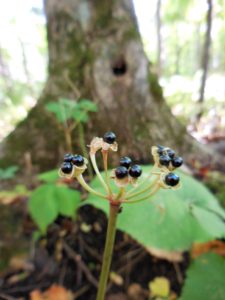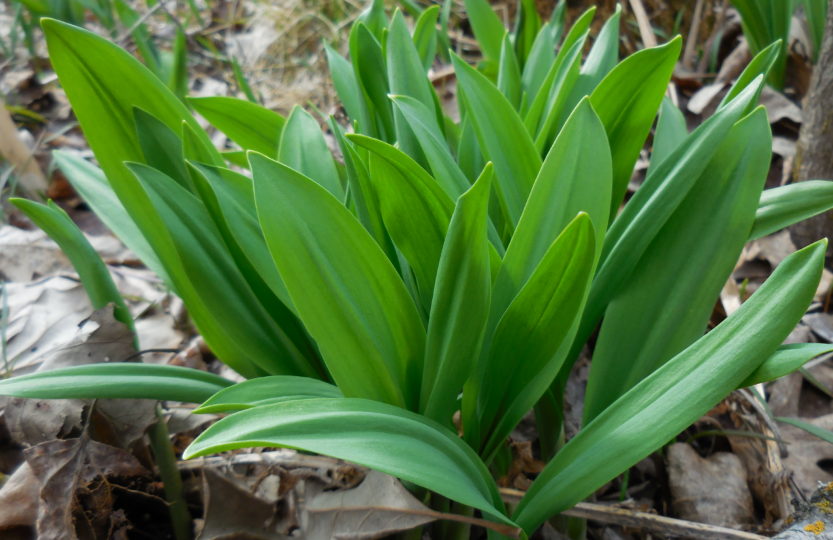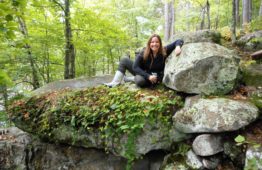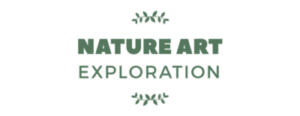It’s April, and my family and I are getting excited for spring foraging. Over the next several weeks, I’ll be sharing this excitement with posts focused on foraging and wildcrafting. We’ll discuss a few plants that are easy to recognize, positively identify, and harvest sustainably. There will also be some fun, educational ways to get kids excited about the world of plants and ways to support their enthusiasm. Nourishing your family with food straight from the creator’s garden is a great way to re-establish your connection to the earth and re-center your awareness on the gifts we are provided every day. Nature sustains us. Nature supports life on our planet. These gifts are not infinite, and we cannot keep taking without giving back and being sustainable in our choices. Our health and viability as a species depends on this recognition and on our ability to globally re-align our thinking to putting the earth at the center.
This week, I would like to focus on Wild Leek, Allium tricoccum. In the Ojibwe language, it is called Zhigaagawanzh. I share this name out of my respect for and love of the Ojibwe language and culture. Know that the information here was not passed down traditionally. This post does not claim to serve as a source of traditional Ojibwe knowledge. If you would like to know Ojibwe knowledge surrounding Zhigaagawanzh, find an elder or other knowledgeable person and ask them if they would be so kind as to share. Offering asemaa (tobacco) when asking is the proper and respectful way to go about doing so. Most of my foraging knowledge comes from my research and my relationships with plants. I don’t know much, but I will still share it. The times I see the world in right now we need to be sharing our gifts in good ways, and so I will share my bliss in the hopes that it helps to make a ripple if even in just the tiniest of ways.
How do you Identify Wild Leek?
The first thing I always become aware of when I forage a new, wild food is potential look-a-likes and possible precautions on the specific plant including potential allergies. Prior to harvest, you want to be 100% on your identification. I worked with a research botanist doing surveys, worked in a native plant greenhouse, and helped establish native plant wild food gardens, prior to getting comfortable with the plants that my family and I bring to our table. Knowing the plant is the first step. This doesn’t have to happen overnight. Spending time with plants, observing them, and getting to know them in your own way is a good start. If you know someone who you can trust in their ability to identify plants, great. As writer of this blog, I hold no liability for your harvesting decision. I only share my own personal experiences and knowledge. Use utmost caution in your choice to harvest any wild food. If you choose to make the harvest, that is your own personal decision.
Wild Leek does have one look-a-like. The differences are easy to spot. Lily-of-the-Valley, Convallaria majalis, which is considered a deadly look-a-like, is very different. The leaves of both plants are similar. However, Lily-of-the-Valley has leaves that are thicker, swirl together into the stem, and the flowers of the plant are hanging and bell-shaped. The flowers are not always present, so don’t let that be the distinguishing factor. The smell of the plant will give it away. Wild Leek has a very strong oniony scent. Lily-of-the-Valley does not. I am not familiar with any precautions for Wild Leek, but as with any new, wild food only try a small amount at first to make sure that the food agrees with you. Everyone is different.
Wild Leeks, also called Ramps, are spring ephemerals that begin popping up once the snow has disappeared around late-April to early May. You can find them carpeting the forest floor in rich, moist, hardwood forests and on the floodplains of small rivers. In the place we do our spring foraging along the river, Spring Beauties, Trout Lilies, and Dutchman’s breeches grow nearby. Wild Leeks have 2-3 basal leaves which are lanceolate. At the base where the leaves narrow, it is often a maroon color. Leaves are 6-12 inches long and up to 2 ½ inches wide. They have a rubbery feel and no distinct mid-vein. The bulbs have fibrous roots at the base. You’ll know you’ve found a ramp patch when you crush the leaves and get a strong smell of onions.
Minnesota Wildflowers is a great online resource for identifying plants. I always use several books or other resources to cross-check my identification. Wild Leek can completely carpet the forest floor in some areas during the spring. After the leaves die back and the flower blooms, you can find the dry stalk which has small, round black seeds. Looking for these stalks can help you locate ramp patches to think about harvesting the following spring. Here’s a good map by the USDA that shows Wild Leek distribution in the United States.
How do you Sustainably Harvest Wild Leek?
Harvest Wild Leeks after their leaves emerge but before the leaves get tough. They are best while they are still young, not yet full size. It’s really important to think about sustainably harvesting each time you’re out foraging. In some areas, Wild Leeks have been exploited and harvested to the extreme for commercial purposes. This is not responsible. Don’t do it. If you find a large patch of Wild Leeks, think about how you can connect to this patch of land, sustainably harvest, and return to this “garden” in future years being mindful to never take in excess. Even if you don’t plan to return to the same patch, harvest in a manner that cares for the ecosystem you are entering.
Make sure you are not harvesting from an area that is polluted or near a source of pollution. When harvesting Wild Leek, some people use the whole plant, but you don’t need to. I strongly encourage harvesting only the leaves and leaving the bulbs. It takes a long time for Wild Leek to regrow. Selectively harvesting one leaf from each plant in a spread out manner will ensure the plants regrow next year. Some clumps are decades old. If you do harvest the whole plant, please make sure there is an abundance. Only harvest a few from each clump and jump around making sure to harvest in a spread out manner. Before harvesting any wild edible, check the status of the plant in your location. If Wild Leek is endangered, rare, or the populations are seeing a decline in your area, please choose to leave it grow.
In some areas, there can be vast stretches of Wild Leek patches. If you do harvest the whole plant in these instances, use a small trowel or digging stick to selectively unearth Wild Leek and carefully replace the soil. Some people cut the bulb above the roots leaving the roots intact in the ground. This often still kills the plant. Take your time when foraging. Don’t be rushed. Being mindful in your approach is always best, and remember that it takes a long time for Wild Leeks to regrow. Don’t over harvest in any given area and never take more than you will use. Harvesting the leaves taking one leaf off each plant is truly the most sustainable choice. It will ensure that the plant continues growing. These leaves stay wonderfully in the fridge for a week or so until use.
What are some ways Wild Leek can be Prepared?
Wild Leek can be preserved by dehydrating or pressure canning. You can also freeze them. I’m not going to get in-depth on how to do so, but if you are interested, you can find a lot of information online on the various methods. You’ll also find a lot of recipes. Wild Leek can be added to spring green salads, chopped up and put in soups, tossed into dishes, and made into pesto. You can eat them cooked or uncooked. Use them in any dish that calls for onions. I really like Wild Leek with farm fresh eggs and our favorite wild mushrooms. Sometimes, we have dried Morel Mushrooms or frozen packages of Honey Mushrooms to complement our spring fare.
Have you Checked out the New Products at Nature Art Exploration?
Nature Art Exploration is starting to add a few new, affiliate products to the shop that can aid you in some of the explorations here. Check out the great books by Sam Thayer while you’re there! The Forager’s Harvest DVD is also excellent. It has over 3 hours of instruction covering all 32 plants that were covered in his Forager’s Harvest book (including Wild Leek). I continually return to these books, and the DVD as references.
*This post contains affiliate links. A small percentage of all the purchases you make by following the above links will help support this site. Thank you for choosing to support Nature Art Exploration!*
Thank you for joining Nature Art Exploration! Nature’s foods and medicines surround us every day. In the busyness of today’s world and the convenience of consumerism, many have long forgotten the way we are sustained by our mother. It’s time to open our door and head outside. It’s time to open up to the simple things, the blessings that we’re passing by daily without acknowledgement. Please, feel free to join in with your comments here. Nature Art Exploration loves hearing from you!







i would be happy to share my canning recipe for wild ramps–great on a sandwich–
Please do! Could you share it on the comments here? That would be so wonderful. My family is excited to try new recipes this year, and others here at Nature Art Exploration would love ideas. Thank you!